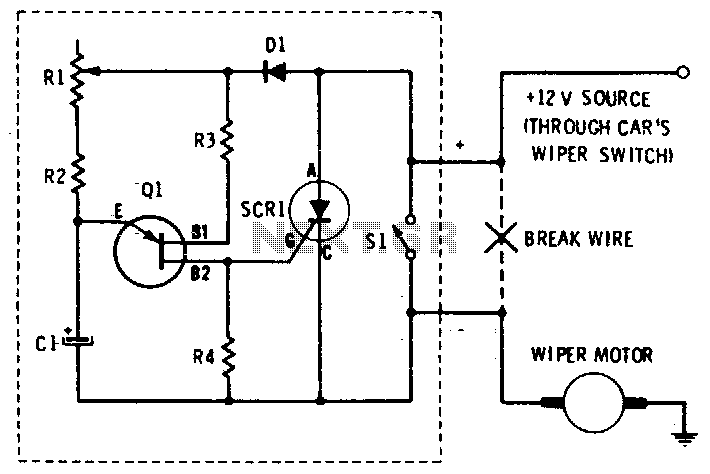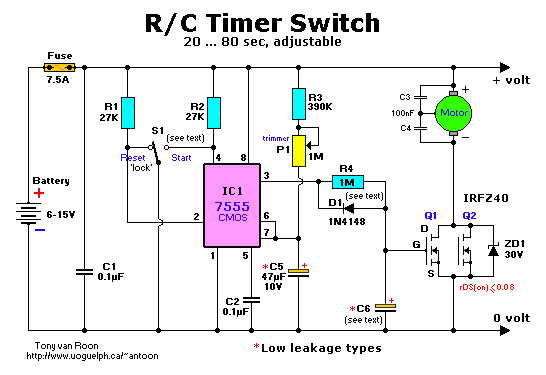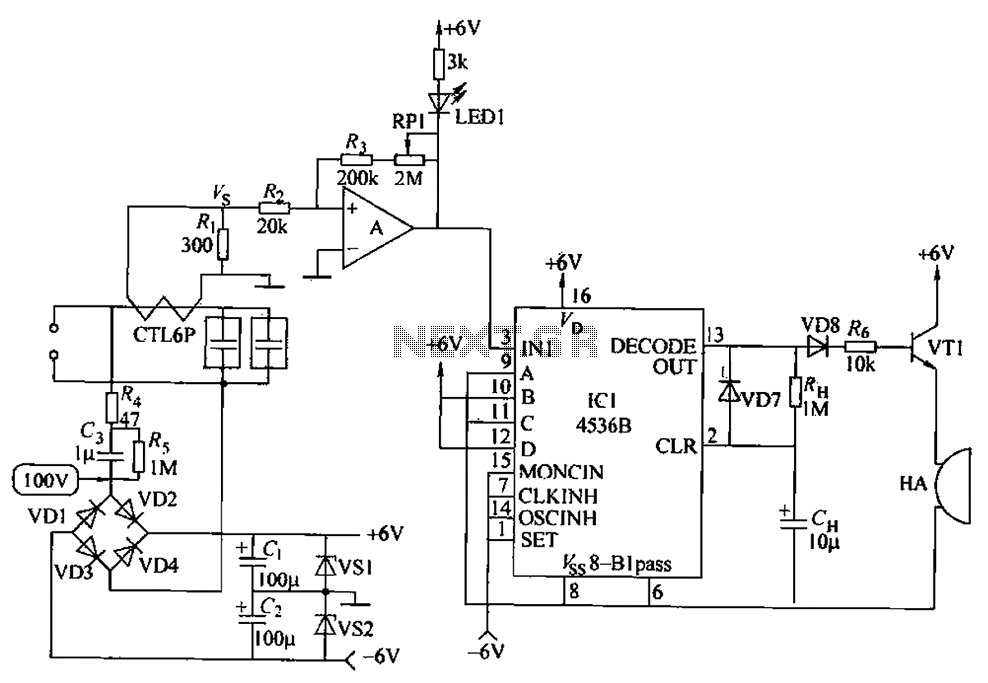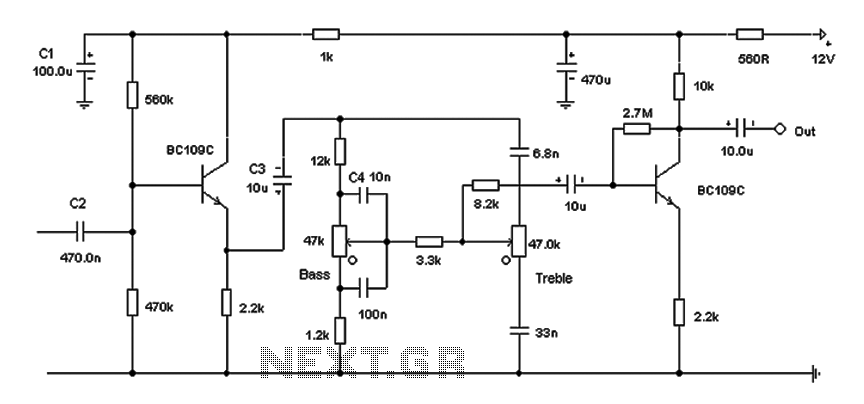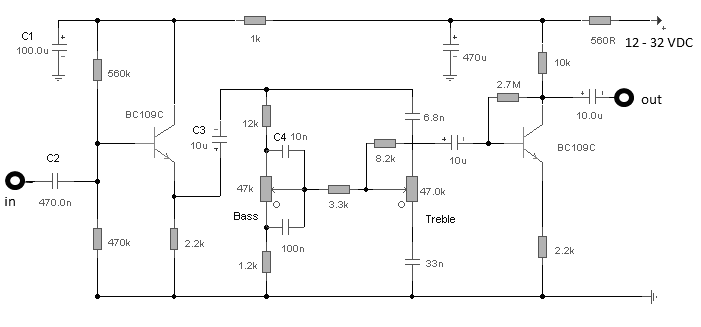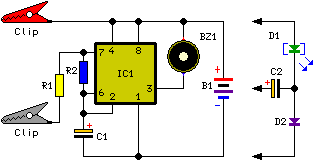
Water Level control and monitor with PIC12F675
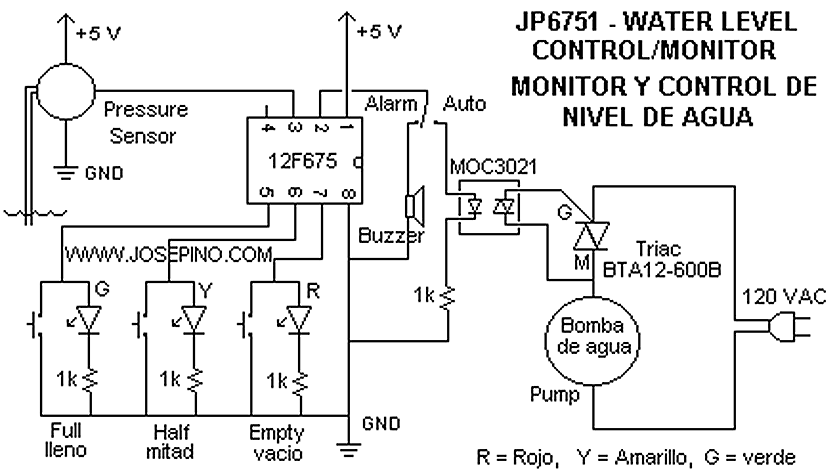
I found some similar circuits but aren't good enough for me. Some circuits measure the water's resistance to determine the level. That is dangerous for drinking water (contamination) or explosive liquids because electricity is in contact with water. The Pressure sensor have a tube. The tube end on the bottom of the tank. When the liquid fill the tank, the pressure inside the tube increases. The 12F675 have A/D converters. The PIC measures the pressure and lights up the LED corresponding to the liquid level. Green LED = Full, Yellow = Half, Red = Almost Empty. When the tank is completely empty, it turns on the water pump or activates the buzzer. Before using the circuit, you have to calibrate it. First, start filling the tank (just one or two inches) and press the switch on the RED LED (Empty). Fill the tank to the half and press the switch on the YELLOW LED. Finally, when the tank is full, press the switch on the GREEN LED. The water pump will stop. When the tank is almost empty the PIC will turn on the pump until the liquid level reaches the top. Use any resistive pressure sensor, just check the sensor works with 5 Volts. I found that washing machines use this method to determine the water level; however, the pressure sensor in a washing machine is not a resistive one, it is just a switch.
The circuit described utilizes a PIC12F675 microcontroller, which features built-in analog-to-digital (A/D) converters, to monitor the water level in a tank through a pressure sensor. The pressure sensor is connected via a tube that reaches the bottom of the tank, allowing it to measure the hydrostatic pressure exerted by the liquid. As the liquid fills the tank, the pressure in the tube increases proportionally to the liquid height, which the PIC interprets through its A/D converters.
The microcontroller is programmed to light up different colored LEDs based on the liquid level. A green LED indicates that the tank is full, a yellow LED signifies that the tank is half full, and a red LED indicates that the tank is almost empty. In the event that the tank is completely empty, the microcontroller activates a water pump or buzzer to signal the need for refilling.
Calibration of the system is crucial for accurate operation. The user must fill the tank to specific levels and press corresponding switches to set the reference points for the empty, half, and full states of the tank. This ensures that the microcontroller can accurately gauge the water level based on the pressure readings from the sensor.
The circuit is designed to operate with a 5-volt power supply, which is suitable for the chosen resistive pressure sensor. It is important to select a sensor that is compatible with this voltage to ensure proper functionality and safety, particularly when dealing with liquids that may pose a contamination risk if electrical components come into direct contact with water.
This method of water level detection is similar to techniques employed in washing machines, although those typically utilize mechanical switches rather than resistive sensors. The design is adaptable and can be modified to include additional features, such as wireless notifications or integration with home automation systems, depending on user requirements.I found some similar circuits but aren't good enough for me. Some circuits measure the water's resistance to determine the level. That is dangerous for drinking water (contamination) or explosive liquids because electricity is in contact with water. The Pressure sensor have a tube. The tube end on the botton of the tank. When the liquid fill the tank, the pressure inside the tube increase. The 12F675 have A/D converters. The PIC measure the pressure and light up the led corresponding to the liquid level. Green LED = Full, Yellow = Half, Red = Almost Empty. When the tank is completely empty, It turn on the Water pump or activate the buzzer. Before using the circuit, you have to calibrate it. First, start filling the thank (just one or two inches) and press the switch on the RED led (Empty). Fill the thank to the half and press the switch on the YELLOW led. Finally, when the tank is full, press the swith on the GREEN led. The water pump will stop. When the tank is almost empty the PIC will turn on the pump until the liquiq level reach the top. USE ANY RESISTIVE PRESSURE SENSOR, JUST CHECK THE SENSOR WORKS WITH 5 Volts. Update: I found that washer machines uses this method to determine the water level, however, the pressure sensor in a washer machine is not a resistive one, is just a switch. 🔗 External reference
The circuit described utilizes a PIC12F675 microcontroller, which features built-in analog-to-digital (A/D) converters, to monitor the water level in a tank through a pressure sensor. The pressure sensor is connected via a tube that reaches the bottom of the tank, allowing it to measure the hydrostatic pressure exerted by the liquid. As the liquid fills the tank, the pressure in the tube increases proportionally to the liquid height, which the PIC interprets through its A/D converters.
The microcontroller is programmed to light up different colored LEDs based on the liquid level. A green LED indicates that the tank is full, a yellow LED signifies that the tank is half full, and a red LED indicates that the tank is almost empty. In the event that the tank is completely empty, the microcontroller activates a water pump or buzzer to signal the need for refilling.
Calibration of the system is crucial for accurate operation. The user must fill the tank to specific levels and press corresponding switches to set the reference points for the empty, half, and full states of the tank. This ensures that the microcontroller can accurately gauge the water level based on the pressure readings from the sensor.
The circuit is designed to operate with a 5-volt power supply, which is suitable for the chosen resistive pressure sensor. It is important to select a sensor that is compatible with this voltage to ensure proper functionality and safety, particularly when dealing with liquids that may pose a contamination risk if electrical components come into direct contact with water.
This method of water level detection is similar to techniques employed in washing machines, although those typically utilize mechanical switches rather than resistive sensors. The design is adaptable and can be modified to include additional features, such as wireless notifications or integration with home automation systems, depending on user requirements.I found some similar circuits but aren't good enough for me. Some circuits measure the water's resistance to determine the level. That is dangerous for drinking water (contamination) or explosive liquids because electricity is in contact with water. The Pressure sensor have a tube. The tube end on the botton of the tank. When the liquid fill the tank, the pressure inside the tube increase. The 12F675 have A/D converters. The PIC measure the pressure and light up the led corresponding to the liquid level. Green LED = Full, Yellow = Half, Red = Almost Empty. When the tank is completely empty, It turn on the Water pump or activate the buzzer. Before using the circuit, you have to calibrate it. First, start filling the thank (just one or two inches) and press the switch on the RED led (Empty). Fill the thank to the half and press the switch on the YELLOW led. Finally, when the tank is full, press the swith on the GREEN led. The water pump will stop. When the tank is almost empty the PIC will turn on the pump until the liquiq level reach the top. USE ANY RESISTIVE PRESSURE SENSOR, JUST CHECK THE SENSOR WORKS WITH 5 Volts. Update: I found that washer machines uses this method to determine the water level, however, the pressure sensor in a washer machine is not a resistive one, is just a switch. 🔗 External reference
Warning: include(partials/cookie-banner.php): Failed to open stream: Permission denied in /var/www/html/nextgr/view-circuit.php on line 713
Warning: include(): Failed opening 'partials/cookie-banner.php' for inclusion (include_path='.:/usr/share/php') in /var/www/html/nextgr/view-circuit.php on line 713
